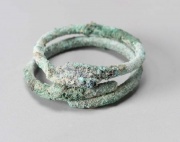Difference between revisions of "Bronze disease"
Jump to navigation
Jump to search
(username removed) |
m (Text replace - "== Authority ==" to "== Sources Checked for Data in Record ==") |
||
| (One intermediate revision by one other user not shown) | |||
| Line 2: | Line 2: | ||
== Description == | == Description == | ||
| − | A destructive corrosion process that occurs on [ | + | A destructive corrosion process that occurs on [[copper]] and [[bronze]] objects. Bronze disease occurs from the reaction of chlorides on copper in the presence of moisture and oxygen. It produces blue-green powdery spots usually containing [[atacamite]] (copper oxychloride). Once initiated, the reaction is cyclic making it difficult to halt, unless the reacting compounds (chloride, water, oxygen) are eliminated. |
== Synonyms and Related Terms == | == Synonyms and Related Terms == | ||
| Line 16: | Line 16: | ||
| − | == | + | == Sources Checked for Data in Record == |
* Ralph Mayer, ''A Dictionary of Art Terms and Techniques'', Harper and Row Publishers, New York, 1969 (also 1945 printing) | * Ralph Mayer, ''A Dictionary of Art Terms and Techniques'', Harper and Row Publishers, New York, 1969 (also 1945 printing) | ||
Revision as of 14:15, 29 April 2016
Description
A destructive corrosion process that occurs on Copper and Bronze objects. Bronze disease occurs from the reaction of chlorides on copper in the presence of moisture and oxygen. It produces blue-green powdery spots usually containing Atacamite (copper oxychloride). Once initiated, the reaction is cyclic making it difficult to halt, unless the reacting compounds (chloride, water, oxygen) are eliminated.
Synonyms and Related Terms
peste du bronze (Fr.); Bronzekrankheit (Deut.); bronspest (Ned.); cancro do bronze (Port.); wild patina; Mehlpatina; flour patina; malignant patina; rogna; caries
Additional Images
Sources Checked for Data in Record
- Ralph Mayer, A Dictionary of Art Terms and Techniques, Harper and Row Publishers, New York, 1969 (also 1945 printing)
- Caring for your Collections, Arthur W Schulz (ed.), Harry N. Abrams, Inc. , New York, 1992
- George Savage, Art and Antique Restorer's Handbook, Rockliff Publishing Corp, London, 1954
- Dictionary of Building Preservation, Ward Bucher, ed., John Wiley & Sons, Inc., New York City, 1996
- External source or communication Comment: H. Otto, "X-ray fine structure investigation of patina samples" Freiberger Forschungshefte.B, 37, 1959, pp. 66-77.


